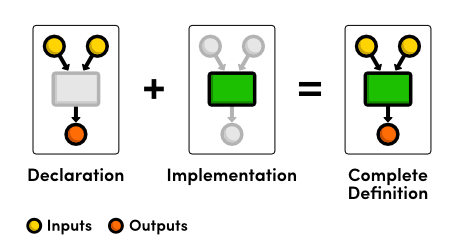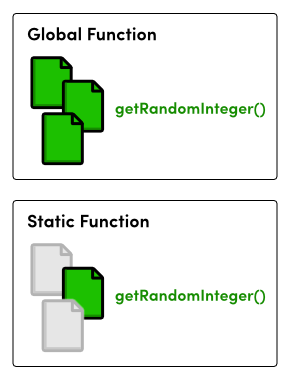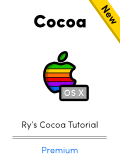You’re reading Ry’s Objective-C Tutorial |
Functions
Along with variables, conditionals, and loops, functions are one of the fundamental components of any modern programming language. They let you reuse an arbitrary block of code throughout your application, which is necessary for organizing and maintaining all but the most trivial code bases. You’ll find many examples of functions throughout the iOS and OS X frameworks.
Just like its other basic constructs, Objective-C relies entirely on the C programming language for functions. This module introduces the most important aspects of C functions, including basic syntax, the separation of declaration and implementation, common scope issues, and function library considerations.
Basic Syntax
There are four components to a C function: its return value, name, parameters, and associated code block. After you’ve defined these, you can call the function to execute its associated code by passing any necessary parameters between parentheses.
For example, the following snippet defines a function called
getRandomInteger() that accepts two int values as
parameters and returns another int value. Inside of the function,
we access the inputs through the minimum and maximum
parameters, and we return a calculated value via the return
keyword. Then in main(), we call this new function and pass
-10 and 10 as arguments.
// main.m#import<Foundation/Foundation.h>intgetRandomInteger(intminimum,intmaximum){returnarc4random_uniform((maximum-minimum)+1)+minimum;}intmain(intargc,constchar*argv[]){@autoreleasepool{intrandomNumber=getRandomInteger(-10,10);NSLog(@"Selected a random number between -10 and 10: %d",randomNumber);}return0;}
The built-in arc4random_uniform()
function returns a random number between 0 and whatever argument you pass. (This
is preferred over the older rand() and random()
algorithms.)
Functions let you use pointer references as return values or parameters,
which means that they can be seamlessly integrated with Objective-C objects
(remember that all objects are represented as pointers). For example, try
changing main.m to the following.
// main.m#import<Foundation/Foundation.h>NSString*getRandomMake(NSArray*makes){intmaximum=(int)[makescount];intrandomIndex=arc4random_uniform(maximum);returnmakes[randomIndex];}intmain(intargc,constchar*argv[]){@autoreleasepool{NSArray*makes=@[@"Honda",@"Ford",@"Nissan",@"Porsche"];NSLog(@"Selected a %@",getRandomMake(makes));}return0;}
This getRandomMake() function accepts an NSArray
object as an argument and returns an NSString object. Note that it
uses the same asterisk syntax as pointer
variable declarations.
Declarations vs. Implementations
Functions need to be defined before they are used. If you were to
define the above getRandomMake() function after
main(), the compiler wouldn’t be able to find it when you
try to call it in main(). This imposes a rather strict structure
on developers and can make it hard to organize larger applications. To solve
this problem, C lets you separate the declaration of a function from its
implementation.

A function declaration tells the compiler what the function’s inputs and outputs look like. By providing the data types for the return value and parameters of a function, the compiler can make sure that you’re using it properly without knowing what it actually does. The corresponding implementation attaches a code block to the declared function. Together, these give you a complete function definition.
The following example declares the getRandomMake() function so
that it can be used in main() before it gets implemented. Notice
that the declaration only needs the data types of the parameters—their
names can be omitted (if desired).
// main.m#import<Foundation/Foundation.h>// DeclarationNSString*getRandomMake(NSArray*);intmain(intargc,constchar*argv[]){@autoreleasepool{NSArray*makes=@[@"Honda",@"Ford",@"Nissan",@"Porsche"];NSLog(@"Selected a %@",getRandomMake(makes));}return0;}// ImplementationNSString*getRandomMake(NSArray*makes){intmaximum=(int)[makescount];intrandomIndex=arc4random_uniform(maximum);returnmakes[randomIndex];}
As we’ll see in Function Libraries, separating function declarations from implementations is really more useful for organizing large frameworks.
The Static Keyword
The static keyword lets you alter the availability of a
function or variable. Unfortunately, it has different effects depending on
where you use it. This section explains two common use cases for the
static keyword.
Static Functions
By default, all functions have a global scope. This means that as soon as
you define a function in one file, it’s immediately available everywhere
else. The static specifier lets you limit the function’s
scope to the current file, which is useful for creating “private”
functions and avoiding naming conflicts.

The following example shows you how to create a static function. If you were
to add this code to another file (e.g., a dedicated function library), you
would not be able to access getRandomInteger() from
main.m. Note that the static keyword should be used
on both the function declaration and implementation.
// Static function declarationstaticintgetRandomInteger(int,int);// Static function implementationstaticintgetRandomInteger(intminimum,intmaximum){returnarc4random_uniform((maximum-minimum)+1)+minimum;}
Static Local Variables
Variables declared inside of a function (also called automatic local
variables) are reset each time the function is called. This is an
intuitive default behavior, as the function behaves consistently regardless of
how many times you call it. However, when you use the static
modifier on a local variable, the function “remembers” its value
across invocations.

For example, the currentCount variable in the following snippet
never gets reset, so instead of storing the count in a variable inside of
main(), we can let countByTwo() do the recording for
us.
// main.m#import<Foundation/Foundation.h>intcountByTwo(){staticintcurrentCount=0;currentCount+=2;returncurrentCount;}intmain(intargc,constchar*argv[]){@autoreleasepool{NSLog(@"%d",countByTwo());// 2NSLog(@"%d",countByTwo());// 4NSLog(@"%d",countByTwo());// 6}return0;}
But, unlike the static functions discussed in the previous section, this use
of the static keyword does not affect the scope of local
variables. That is to say, local variables are still only accessible inside of
the function itself.
Function Libraries
Objective-C doesn’t support namespaces, so to prevent naming
collisions with other global functions, large frameworks need to prefix their
functions (and classes) with a unique identifier. This is why you see built-in
functions like NSMakeRange()
and CGImageCreate()
instead of just makeRange() and imageCreate().
When creating your own function libraries, you should declare functions in a
dedicated header file and implement them in a separate implementation file
(just like Objective-C classes). This lets files
that use the library import the header without worrying about how its functions
are implemented. For example, the header for a CarUtilities
library might look something like the following:
// CarUtilities.h#import<Foundation/Foundation.h>NSString*CUGetRandomMake(NSArray*makes);NSString*CUGetRandomModel(NSArray*models);NSString*CUGetRandomMakeAndModel(NSDictionary*makesAndModels);
The corresponding implementation file defines what these functions actually
do. Since other files are not supposed to import the implementation, you can
use the static specifier to create “private” functions
for internal use by the library.
// CarUtilities.m#import"CarUtilities.h"// Private function declarationstaticidgetRandomItemFromArray(NSArray*anArray);// Public function implementationsNSString*CUGetRandomMake(NSArray*makes){returngetRandomItemFromArray(makes);}NSString*CUGetRandomModel(NSArray*models){returngetRandomItemFromArray(models);}NSString*CUGetRandomMakeAndModel(NSDictionary*makesAndModels){NSArray*makes=[makesAndModelsallKeys];NSString*randomMake=CUGetRandomMake(makes);NSArray*models=makesAndModels[randomMake];NSString*randomModel=CUGetRandomModel(models);return[randomMakestringByAppendingFormat:@" %@",randomModel];}// Private function implementationstaticidgetRandomItemFromArray(NSArray*anArray){intmaximum=(int)[anArraycount];intrandomIndex=arc4random_uniform(maximum);returnanArray[randomIndex];}
Now, main.m can import the header and call the functions as if
they were defined in the same file. Also notice that trying to call the static
getRandomItemFromArray() function from main.m results
in a compiler error.
// main.m#import<Foundation/Foundation.h>#import"CarUtilities.h"intmain(intargc,constchar*argv[]){@autoreleasepool{NSDictionary*makesAndModels=@{@"Ford":@[@"Explorer",@"F-150"],@"Honda":@[@"Accord",@"Civic",@"Pilot"],@"Nissan":@[@"370Z",@"Altima",@"Versa"],@"Porsche":@[@"911 Turbo",@"Boxster",@"Cayman S"]};NSString*randomCar=CUGetRandomMakeAndModel(makesAndModels);NSLog(@"Selected a %@",randomCar);}return0;}
Summary
This module finished up our introduction to the C programming language with an in-depth look at functions. We learned how to declare and implement functions, change their scope, make them remember local variables, and organize large function libraries.
While most of the functionality behind the Cocoa and Cocoa Touch frameworks
is encapsulated as Objective-C classes, there’s no shortage of built-in
functions. The ones you’re most likely to encounter in the real world are
utility functions like NSLog() and convenience functions like
NSMakeRect() that create and configure complex objects using a
friendlier API.
We’re now ready to start tackling the object-oriented aspects of Objective-C. In the next module, we’ll learn how to define classes, instantiate objects, set properties, and call methods.
 |
Be sure to check out Ry’s Cocoa Tutorial. This brand new guide is a complete walkthrough of Mac App development, and it leverages all of the Objective-C skills that we just discussed. Learn more › |
Mailing List
Sign up for my low-volume mailing list to find out when new content is released. Next up is a comprehensive Swift tutorial planned for late January.
You’ll only receive emails when new tutorials are released, and your contact information will never be shared with third parties. Click here to unsubscribe.